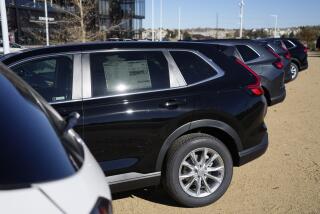GM’s March Sales Decline 2% as Rest of Industry Sees Substantial Gains
DETROIT — General Motors Corp., sharply bucking an industry trend of record sales, on Wednesday reported a disappointing 2% decline in March auto sales as it struggled to supply dealers with enough of its hottest-selling new truck.
Despite GM’s weak performance, U.S. vehicle sales jumped 8% in March to a record 1.54 million units as consumers were spurred by low interest rates, low unemployment levels, robust wage gains and high consumer confidence. First-quarter results, also a record, increased 11%, with sales hitting a seasonally adjusted annual rate of 16.3 million units.
But GM, the nation’s leading auto maker, again failed to meet expectations. Its market share is a mere 29.1% for the year, far below the 32% target set earlier by top officials. A year ago, its market share was 30.6%.
Roy Roberts, GM vice president of sales, service and marketing, said meeting the earlier goal would require a flawless performance, something he admitted the company was unlikely to achieve.
GM traced its poor sales performance to difficulty in producing enough new Chevrolet Silverado full-size pickups, rail transit problems from Canadian factories and glitches with its computerized vehicle ordering system.
But analysts said GM’s problems were more systemic. They cited a lackluster car-heavy product lineup and an inability to bring new vehicles to showrooms quickly.
“To paraphrase a politician, ‘It’s the product, stupid,’ ” said David Healy, analyst with Burnham Investment Research. “With the exception of the new full-size pickups, the public response to GM’s lineup is tepid.”
The auto maker’s woes come as most of the U.S. auto industry is enjoying one of its biggest and longest booms. The current light-vehicle sales pace, if sustained, would break the sales record of 16 million set in 1986.
“The industry is torrid,” said Michael DiGiovanni, GM director of market research.
Although GM’s sales slumped in March, other major auto makers saw impressive gains. Ford Motor Co. sales jumped 14%, DaimlerChrysler’s were up 17%, Toyota Motor Co.’s increased 8% and Nissan Motor Co.’s gained 4%.
Most analysts and industry officials do not believe that the current sales pace is sustainable for much longer. They expect vehicle buying--an important gauge of the economy’s health--to ease somewhat in the year’s second half, particularly if the strong economy fires up inflation and pushes up interest rates.
“I see a big drop in the second half,” said George Magliano, analyst for WEFA Group in New York. “Incentives will dry up and the economy will slow.”
But others believe there has been a fundamental shift in consumer behavior that is likely to keep the economy firing on all cylinders, maintaining auto sales at robust levels for some time.
“We have a new generation of savvy consumers,” said Chris Cedergren, auto consultant with Nextrend. “They understand the economy, mergers and the stock market. Unlike the past, they don’t panic on economic gyrations.”
He expects the second quarter to be another blockbuster period for auto sales, with some cooling in the year’s second half. But he predicts sales this year and next will be healthy unless some external shock rocks the economy.
The most recent three months will be difficult to top. Car sales rose 5% and sales of light trucks--pickups, sport-utility vehicles and minivans--jumped 11%.
Hurt by a shortage of Silverados and an aging lineup of compact pickups, GM reported a 6% decline in truck sales. A year ago, spurred by large rebates, GM sold a record number of light trucks.
GM said demand for the Silverado was so strong that it simply could not build enough fast enough. The company estimates it could have sold 10,000 more big pickups had they been available.
“We didn’t have enough inventory,” Roberts told reporters at a news briefing in Detroit.
Sales of the compact S-10 Chevy pickup truck fell 22%. GM blamed the dip on hefty incentives from competitors, but analysts said the aging S-10 was having trouble competing with Ford’s newer four-door Ranger pickup. Ranger sales were up 67% in March.
GM sales were also hurt by the difficulty dealers had in ordering vehicles using a new computerized ordering system. Roberts acknowledged the problems, and he also mentioned the disruption caused by the recent reorganization of GM’s North American sales operation. Those problems are abating, he said.
(BEGIN TEXT OF INFOBOX / INFOGRAPHIC)
Top 20 Sellers on the Lot
The following are the 20 top-selling vehicles in the United States through March 1999 as reported by the auto makers.
*--*
Year-ago Rank Vehicle 1999 sales 1998 period ’98 rank 1 Ford F-Series pickup 213,910 177,205 1 2 Chevrolet Silverado pickup 142,038 134,926 2 3 Ford Ranger pickup 105,902 70,074 10 4 Toyota Camry 103,466 74,395 8 5 Ford Explorer 102,349 89,722 4 6 Dodge Ram pickup 95,692 87,025 6 7 Honda Accord 94,939 91,322 3 8 Dodge Caravan 81,987 70,159 9 9 Ford Taurus 81,932 88,244 5 10 Chevrolet Cavalier 76,171 65,516 12 11 Ford Escort 70,828 65,951 11 12 Honda Civic 69,150 75,444 7 13 Jeep Grand Cherokee 68,270 55,660 14 14 Toyota Corolla 57,876 53,264 15 15 Ford Windstar 56,970 45,444 NA 16 Pontiac Grand Am 55,712 32,389 NA 17 Ford Expedition 54,473 46,197 20 18 Saturn* 50,558 51,223 16 19 Chevrolet Malibu 49,269 50,966 17 20 Chevrolet Blazer 48,177 49,774 18
*--*
* Includes sales of EV1 electric car.
Source: Reuters






